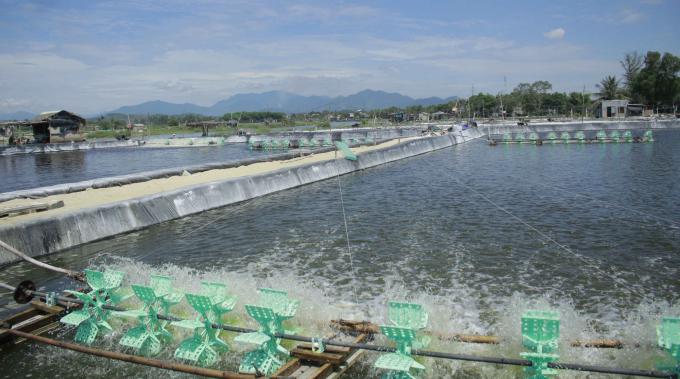November 28, 2025 | 02:49 GMT +7
November 28, 2025 | 02:49 GMT +7
Hotline: 0913.378.918
November 28, 2025 | 02:49 GMT +7
Hotline: 0913.378.918

MARD will submit to the Government for approval of the National Program for Aquaculture Development in September 2021.
MARD Deputy Minister Phung Duc Tien on September 20 chaired a meeting with the Directorate of Fisheries and related units to complete soon a project on the implementation of the National Program for Aquaculture Development (NPAD). As scheduled, MARD will submit the project to the Government for approval in September 2021.
According to Deputy Minister Phung Duc Tien, NPAD is a large project and has many components thus it should look to restructuring the agricultural sector, especially to increasing the added value of agricultural products. Since then, it should also be associated with the restructuring of three agricultural product axes: nation, region and OCOP.
The Deputy Minister also said that in the context of the Covid-19 pandemic’s complicated development that has been heavily affecting the agriculture industry in general and the fisheries sector in particular, aquacultural production and farming need to be developed in a chain so that it is able to trace the origin and ensure market standards of food hygienic safety.
“From the current context and existing advantages, the Program must come up with solutions. Projects to implement those solutions should go along with the financial mechanism. In particular, there must be specific projects on veterinary medicine for preventing aquatic diseases, food hygiene and safety. The scheme on aquaculture in the sea and on the field also needs more attention,” noted the MARD Deputy Minister.
The NPAD is built basing on the viewpoint of promoting aquacultural industrialization and modernization in a market-orientation, environmental-friendly manner, adapting to climate change and ensuring epidemic and biological safety as well as social security.
Besides, it is aimed to boost aquaculture development in the direction of a circular economy, improving productivity, quality, value and economic efficiency.
The program is to develop aquaculture in association with improving people's material and spiritual life and building new countryside.
It will attract resources and the participation of economic sectors to invest and develop aquaculture effectively with business as the core factor.
Investment in synchronous technical and infrastructure facilities will be a focus for concentrated production areas following a motto of selective priority and definitive investment. The State only invests in key areas as a premise for all economic sectors to invest in developing production.
In addition, aquaculture development must be organized suitable to the production conditions of each region, and object to ensure harmonious coordination, without causing conflicts or contradictions with activities of other economic sectors, especially in coastal areas.
According to the Directorate of Fisheries, the NPAD’s overall goal is to develop a sustainable aquaculture industry based on an increase of productivity, quality and production efficiency.

Shrimp farming on riverside areas in Binh Chanh Commune, Binh Son District, Quang Ngai Province. Photo: Nguyen Trang.
The NPAD is aimed to control input factors issues, production and consumption activities, environment and epidemics, and actively adapt to climate change.
It targets to form concentrated production areas for export with a synchronous infrastructure system, control, and supervision mechanism.
The program is focussing on effectively exploiting and using the potentials of water surface systems, rivers, streams, and reservoirs to develop suitable production models, meeting food hygiene standards, supplying domestic consumption demand, and creating jobs for the people.
It aims to promote natural potentials for aquaculture development as an economic sector with a large scale and high commodity ratio, high value, prestigious brand name, high competitiveness and sustainability.
Accordingly, a number of specific goals in the period 2021 - 2025 have been set, which is to raise the total aquaculture output to over 5.6 million tons, with an average annual production growth rate of 4.2%.
The total export value of aquaculture products reached over US$7.5 billion, up 1.45 times compared to 2020. Export turnover growth reached 7.6%/year. The growth rate of aquaculture production value averages 6-7%/year.
In the period of 2025 - 2030, a goal is set for the total aquaculture production to reach over 7 million tons, with an average growth rate of 4.6%/year. The total export value of aquaculture products is expected to reach over US$12 billion, an increase of 2.3 times compared to 2020. Export turnover growth reaches about 7.6 - 9.9%/year while the growth rate of aquaculture production value averages 8-9%/year.
Translated by Linh Nguyen

(VAN) According to Mr. Vo Minh Thanh, Director of the Tay Ninh Department of Agriculture and Environment, Resolution 57 has created a new development pathway for the locality, shifting from traditional toward modern agriculture.
/2025/11/26/4909-2-154329_878.jpg)
(VAN) Pearl grouper farming in HDPE cages not only delivers economic efficiency but also contributes to protecting the environment, creating jobs, and promoting marine-based experiential tourism.

(VAN) The model of making a living under the forest canopy through the agroforestry system in Van Son commune, Bac Ninh province, is expected to generate an annual income of approximately VND 30 million/ha.

(VAN) Many enterprises in Can Tho are harnessing natural energy and reducing greenhouse gas emissions in their production processes, thereby contributing to the promotion of a sustainable green transition.
/2025/11/24/3536-2-112800_176.jpg)
(VAN) Dong Nai now has tens of thousands of hectares of forests certified for sustainable management, and this area will continue to be expanded in the coming period.

(VAN) Vinh Ha hamlet (Dai Xuyen commune, Hanoi) is shifting away from small-scale farming as households adopt bioscurity into their breeder chicken models.

(VAN) Heavy rains make aquatic species more vulnerable to disease. Proactive water management and high-tech systems help farmers prevent outbreaks and protect yields.